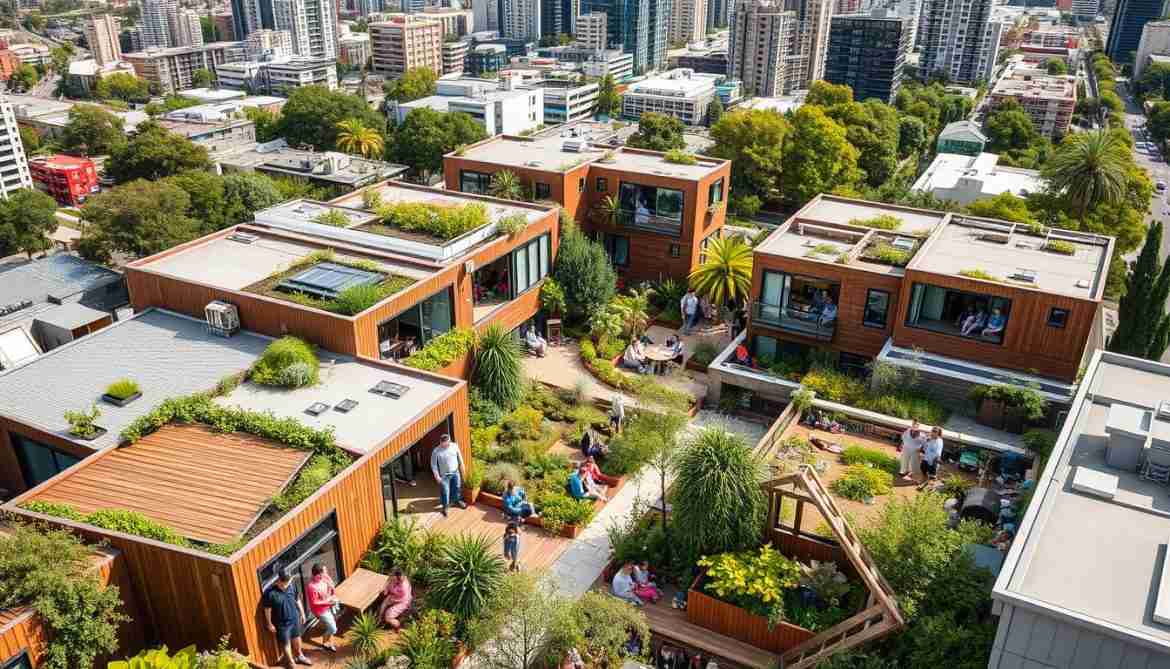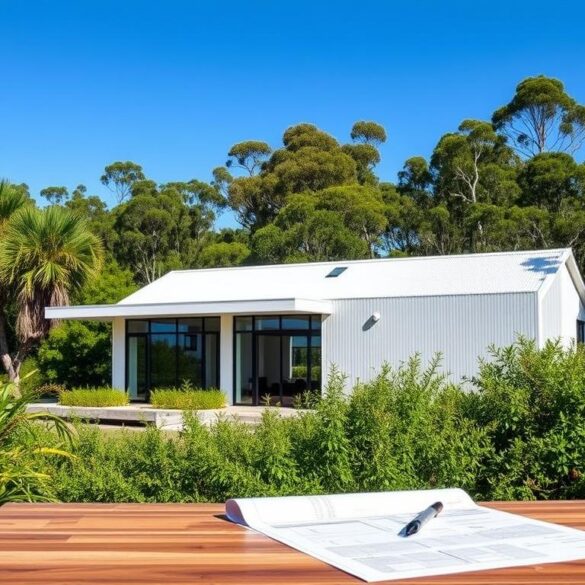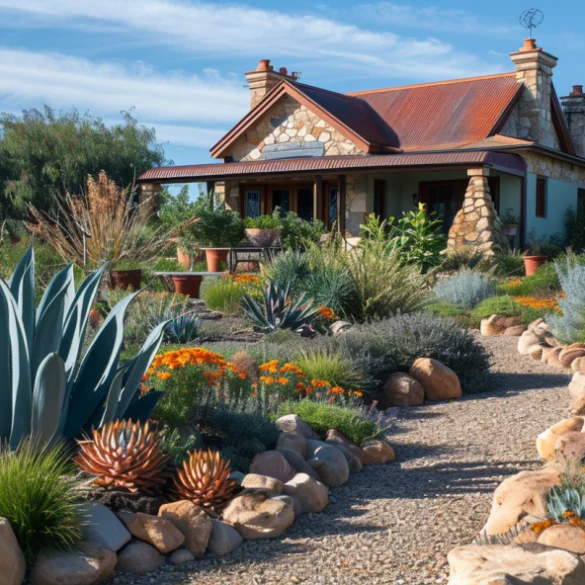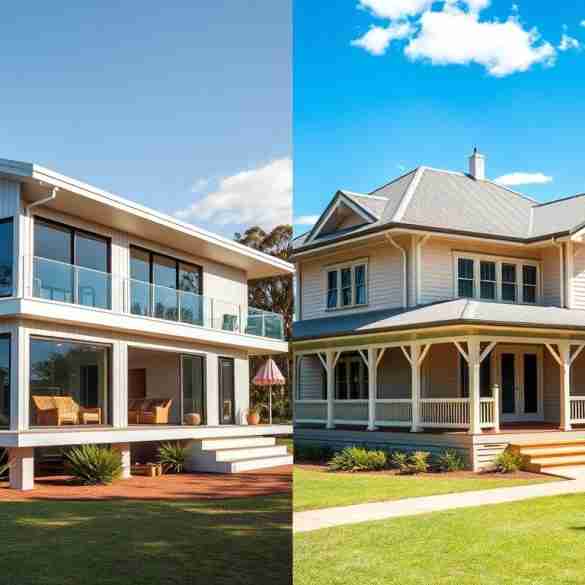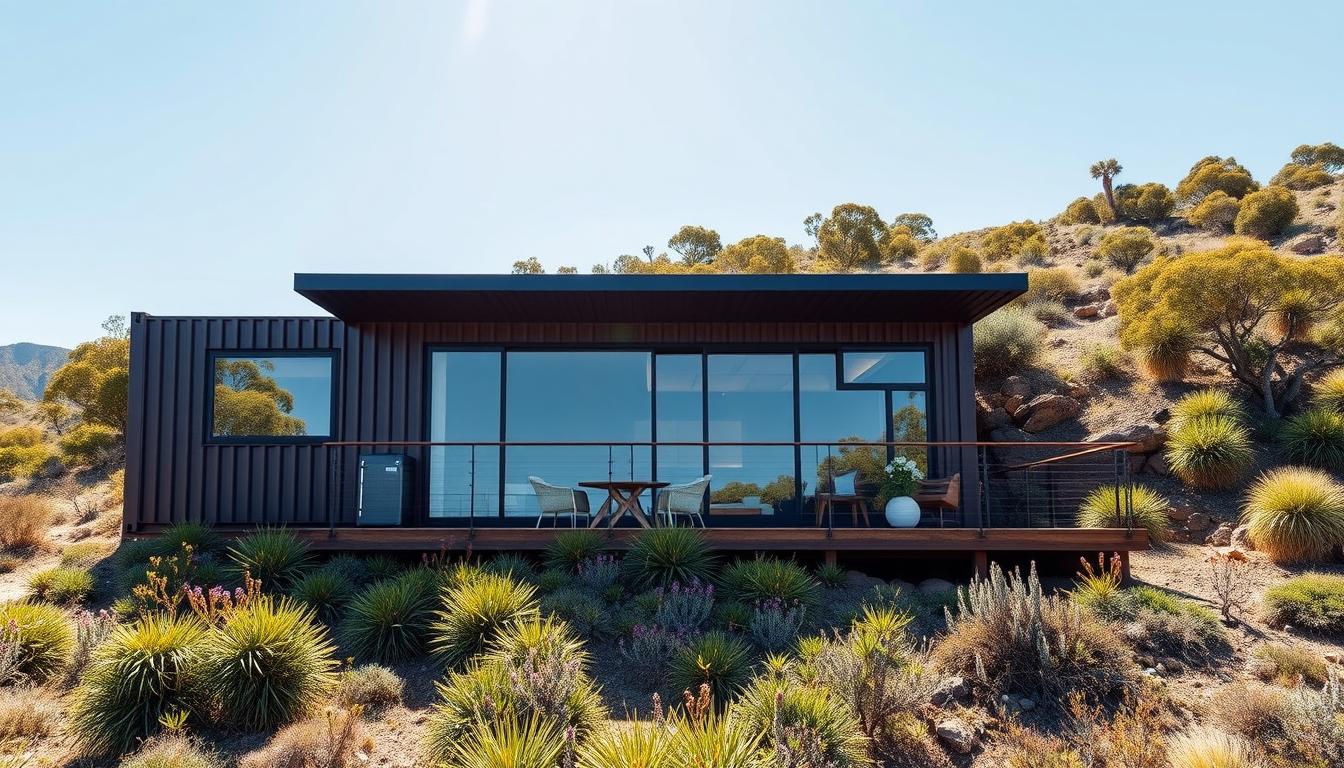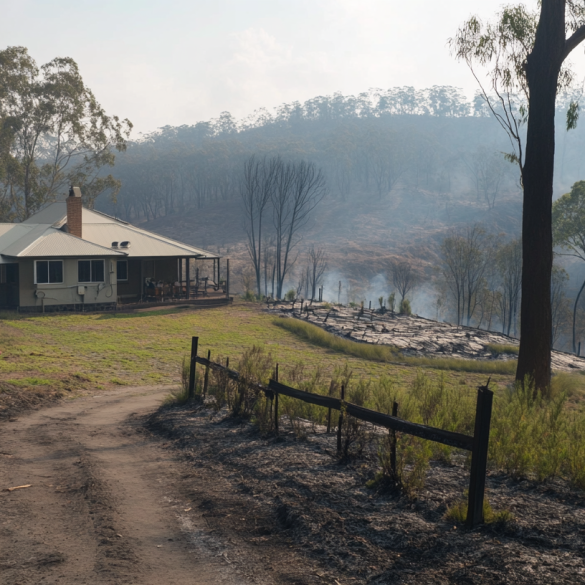Imagine a world where you know your neighbors and share meals. This is the dream of urban co-housing in Australia. It’s a way to live in the city with a sense of community. By mixing private homes with shared spaces, it’s a green and caring choice for housing.
Urban Coup is a great example. It’s a group of 30 people from Melbourne who live together in Brunswick. They come from different careers like law, architecture, and medicine. They’ve built a home that’s good for the planet, with solar power and water-saving features.
Living in a place like Urban Coup has many benefits. It can save money and help you make friends. You also get to live in a way that’s better for the environment. Plus, the homes are built to fit the needs of the people living there.
If you want to live in a more connected way in the city, urban co-housing is worth exploring. Keep reading to find out more about this new way of living in Australia.
Table of Contents
Key Takeaways
- Urban co-housing combines private living spaces with shared amenities to foster community living in the city.
- Benefits of urban co-housing include cost savings, stronger social networks, and higher resident satisfaction.
- Urban Coup is a successful example of urban co-housing in Melbourne, with 30 members from diverse professional backgrounds.
- Sustainable features like passive solar design, water conservation, and renewable energy are prioritized in urban co-housing communities.
- Modular construction and participatory design allow for customization to meet the unique needs and preferences of community members.
What is Urban Co-Housing in Australia?
Urban co-housing is a way to live in cities where you have your own home but share common spaces. It’s becoming popular in Australia as a way to deal with high housing costs, feeling lonely, and caring for the environment.
Defining Urban Co-Housing
Urban co-housing means living in a city with your own home but sharing areas and things. These co-housing developments have different types of homes to fit various families. They also focus on multi-generational housing.
Differences from Suburban Co-Housing
Suburban co-housing has bigger properties and more outdoor space. But urban co-housing fits the city’s tight spaces. It uses tall buildings with shared amenities on different levels. It also makes it easy to walk or use public transport.
Benefits of Urban Co-Housing
Urban co-housing brings many good things to both residents and the community. It helps people feel connected and less lonely in the city. Shared areas and activities help neighbors get to know each other, making communities lively and sustainable.
| Benefit | Description |
|---|---|
| Affordability | Sharing resources and amenities can reduce living costs for residents |
| Social Connection | Regular interactions and shared activities foster a sense of community and belonging |
| Sustainability | Urban co-housing often incorporates eco-friendly features and encourages sustainable living practices |
In Australia, more people want to live in urban co-housing. Projects like Nightingale Housing are getting a lot of interest. The Australian Bureau of Statistics (ABS) says over 350,000 Australians live in group households now. Urban co-housing is seen as a good way to address housing costs and create sustainable communities that benefit everyone.
Challenges of Urban Co-Housing in Australia
Urban co-housing in Australia has many benefits but also faces challenges. These issues must be solved for co-housing to become a common housing choice in cities.

Space Constraints
Space is a big problem for urban co-housing in Australia. Cities are crowded, and land is hard to find and expensive. This makes it tough to find places for co-housing projects.
Old buildings might need big changes to fit co-housing needs. This adds to the cost and makes the project more complex.
Co-Housing Zoning Laws and Regulations in Australia
Zoning laws in Australia can be a big obstacle for co-housing. Local councils often have strict rules that don’t fit co-housing well. It’s hard to get through all the rules and get approval.
But, councils can help co-housing projects:
- Use inclusionary zoning to make some homes affordable
- Relax rules on waste and parking for co-housing
- Give fast advice and permits to speed up the process
- Have design panels and projects to show what co-housing is
- Sell council land cheaply to help co-housing grow
High Costs of Land in Australia
Land costs in Australian cities are very high. Finding good sites is expensive, especially for groups saving together. They also need a lot of money to build or fix up homes.
| City | Median House Price (AUD) | Median Unit Price (AUD) |
|---|---|---|
| Sydney | $1,142,212 | $735,387 |
| Melbourne | $901,951 | $569,677 |
| Brisbane | $577,664 | $392,777 |
| Adelaide | $510,337 | $344,506 |
| Perth | $519,516 | $367,969 |
Planning controls, land prices, and development finance are key barriers to the viability of cohousing projects. Cohousing development often depends on the dedication of residents and collaboration with stakeholders like local councils and lenders.
Despite the challenges, co-housing is still a great choice for many in Australia. It offers a sustainable and community-focused way of living. With teamwork and support from councils, banks, and experts, co-housing can thrive in cities.
Designing an Urban Co-Housing Space in Australia
Designing an urban co-housing space in Australia needs careful thought. It’s about making the most of small urban spaces. This includes creating common areas and green spaces.
Maximizing Space in Urban Areas in Australia
One big challenge is using space wisely in cities. In Australia, land is expensive, and space is limited. Designers must get creative to make co-housing spaces functional and livable. Here are some strategies:
- Use vertical space with multi-story buildings
- Create flexible, multi-purpose rooms
- Design smart storage solutions
- Make the most of natural light and air
Common Areas in Tight Spaces
Even with little space, common areas are key for community in co-housing. Designers must craft inviting, functional shared spaces. Here are some examples:
| Common Area | Purpose | Design Considerations |
|---|---|---|
| Communal kitchen and dining area | Shared meals and socializing | Efficient layout, ample seating, and storage |
| Rooftop terrace | Outdoor gathering space | Maximizing views, incorporating greenery, and providing shade |
| Multipurpose room | Workshops, meetings, and events | Flexible furniture, good acoustics, and technology integration |
| Shared laundry facilities | Convenient and space-saving | Energy-efficient appliances and ample folding space |
Integrating Green Spaces
Green spaces are vital in urban co-housing design. They boost well-being and sustainability. Designers can integrate nature in many ways, like:
- Green roofs and vertical gardens
- Pocket parks and courtyards
- Balcony gardens and planter boxes
- Living walls and green facades
“The Urban Coup building features energy efficiency, passive solar design, double glazing, onsite water collection and reuse. The building is fully electric and fossil fuel free and includes solar power generation.” – Sustainable Home Magazine
By focusing on sustainable design and green spaces, urban co-housing in Australia can create better living environments. These spaces promote community and environmental health.
Examples of Successful Urban Co-Housing Communities in Australia
Urban co-housing is becoming more popular in Australia. Many communities show its benefits. They highlight how it builds community, supports sustainability, and offers affordable housing.
Case Studies in Major Cities in Australia
In Melbourne, the Urban Coup community is a great example. It’s at 24 Hope Street, known as “Near and Tall.” It’s full, but ready to help others start new projects.
Adelaide, Hobart, and Perth also have thriving co-housing communities. They’ve made the model work for urban living in Australia.
Innovations in Urban Co-Housing in Australia
Australian co-housing is leading in new ideas. Some innovations include:
- Using vertical space for compact, affordable homes
- Adding green spaces and rooftop gardens for sustainability
- Using tech for community engagement and decision-making
- Working with governments and investors for funding
Lessons Learned from Established Co-Housing Communities in Australia
Experienced co-housing communities share important lessons. Key points include:
- Good communication and decision-making are crucial
- Balance privacy and communal areas for happiness
- Partnerships with local groups are key to success
- Co-housing helps cities be more sustainable and socially better
As co-housing grows in Australia, these lessons will guide future projects. They’ll help shape the future of this housing model.
Funding Urban Co-Housing Projects in Australia
Financing urban co-housing in Australia is key to making these community-focused living spaces a reality. As demand for affordable, green, and connected housing grows, it’s vital to look at different funding paths. We’ll explore government grants, subsidies, and private investments for financing these projects.
Financing Urban Co-Housing in Australia
Urban co-housing projects in Australia can get funding from personal investments, mortgages, and new funding models. Co-housing members often put in a lot of money upfront. Some projects also get help from ethical investment funds or community banks.
According to Sustainable Home Magazine, co-housing aims to lower living costs by sharing resources and buying in bulk. This makes living sustainable and social.
Government Grants and Subsidies in Australia
The Australian government sees co-housing as a way to tackle housing affordability and build sustainable communities. There are grants and subsidies for co-housing projects. For example, the National Rental Affordability Scheme (NRAS) offers incentives for affordable rental housing.
State and local governments also offer land grants or discounts for co-housing projects that fit their urban planning goals.
| Year | Number of Co-Operative Building Societies in NSW | Membership | Total Assets |
|---|---|---|---|
| 1980 | 3,257 | 63,000 | $732,744 |
Since 1981, Australian housing cooperatives have grown. This is due to a need for low-rental housing for certain groups and less government support for public housing.
Private Investors and Partnerships in Australia
Private investors and partnerships are crucial for funding urban co-housing projects in Australia. Socially responsible investors are drawn to co-housing for its financial and social benefits. They often provide equity or debt financing at good terms.
Partnerships with housing associations, community land trusts, and non-profits can also secure land and resources for co-housing projects.
“Co-housing is appealing to older single women looking for companionship and seeking to reduce living costs. Co-housing projects are particularly beneficial to families aiming to reduce childcare costs.” – Sustainable Home Magazine
As co-housing grows in Australia, with 36 projects through Cohousing Australia, it’s important to explore various funding options. By using government support, private investments, and new financing models, co-housing projects can become more accessible. They can help create vibrant, sustainable communities in Australia’s cities.
Co-Housing and Urban Sustainability
Cities face big challenges in being sustainable. Urban co-housing is a bright spot. It uses green materials, saves energy, and encourages walking. This makes Australia’s co-housing communities a beacon for a greener future.
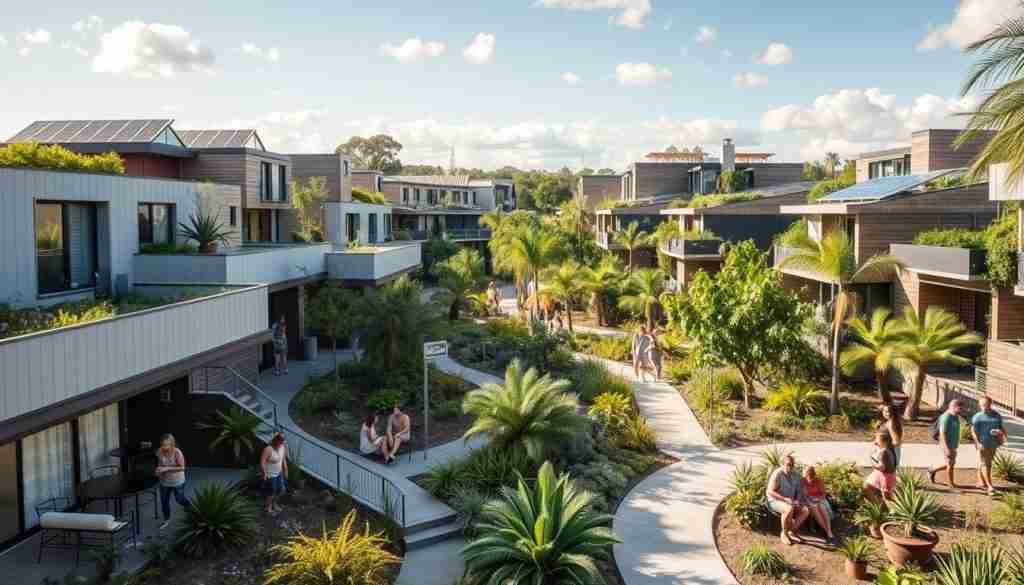
Green Building Materials in Australia
In Australia, co-housing projects are choosing eco-friendly materials. They use recycled wood, paints that don’t harm the air, and green roofs. These choices cut down on carbon emissions and make homes healthier.
A study by the Australian Housing and Urban Research Institute shows a trend. Local governments are pushing for more sustainable building. They see how green building improves life and protects the environment.
Energy Efficiency in Urban Co-Housing
Energy saving is key in Australia’s co-housing. They use solar panels, efficient appliances, and smart tech. This cuts down energy use and emissions.
“Energy efficiency is not just about saving money on utility bills; it’s about creating a more sustainable future for our cities and our planet.” – Sarah Thompson, co-founder of Sustainable Home Magazine
A Swedish study found that working together helps co-housing be green. Sharing resources and knowledge lets residents save energy and reduce waste.
Transportation and Walkability in Australia
Co-housing in Australia focuses on being walkable. They design streets for walking, add bike lanes, and improve public transport. This reduces car use, lowers emissions, and boosts health.
| City | Walkability Score | Public Transport Score |
|---|---|---|
| Melbourne | 90 | 85 |
| Sydney | 88 | 82 |
| Brisbane | 85 | 80 |
The table shows how walkable and transport-friendly major Australian cities are. Co-housing can use these to promote green living.
As more people want sustainable homes, Australia’s co-housing is leading the way. They’re building a greener, more connected future for city folks.
Governance in Urban Co-Housing in Australia
Urban co-housing in Australia faces unique challenges. The diverse populations and close living in cities require special governance. Traditional governance models need to be adapted for city living. This includes how decisions are made and conflicts are resolved.
Adapting Governance Models for Urban Living in Australia
In Australia, co-operatives follow the Co-operatives National Law. This law limits shareholding to 20 percent. It helps balance power and promotes teamwork in decision-making. Urban co-housing can use this model by setting clear rules for member roles and responsibilities.
Decision-Making in Diverse City Populations in Australia
Co-housing in Australia often has 8 to 50 households. This makes decision-making tough. A consensus-based approach can help, where everyone has a say. This way, everyone feels included and participates more.
Having a clear decision-making structure and defined roles helps too. Regular meetings and open communication are key. They ensure everyone’s voice is heard and concerns are quickly addressed.
Conflict Resolution nearby
Living close together in urban co-housing can cause conflicts. It’s important to have a clear way to resolve these. This should include open communication, listening, and being willing to compromise.
Having a neutral mediator or a conflict resolution committee can help. They can lead to solutions that work for everyone. A culture of respect, empathy, and understanding is crucial. It helps keep the community harmonious.
| Governance Aspect | Key Considerations |
|---|---|
| Adapting Models | Limit shareholding, establish clear guidelines |
| Decision-Making | Consensus-based approach, clear hierarchy, regular meetings |
| Conflict Resolution | Open communication, neutral mediator, culture of respect |
By focusing on these governance aspects, urban co-housing in Australia can thrive. It can create a sustainable, peaceful environment for diverse city populations.
Building Community in a City Setting in Australia
Urban co-housing in Australia is a great way to build social bonds in busy cities. It creates shared spaces and activities that bring people together. This helps residents feel connected and part of a community.
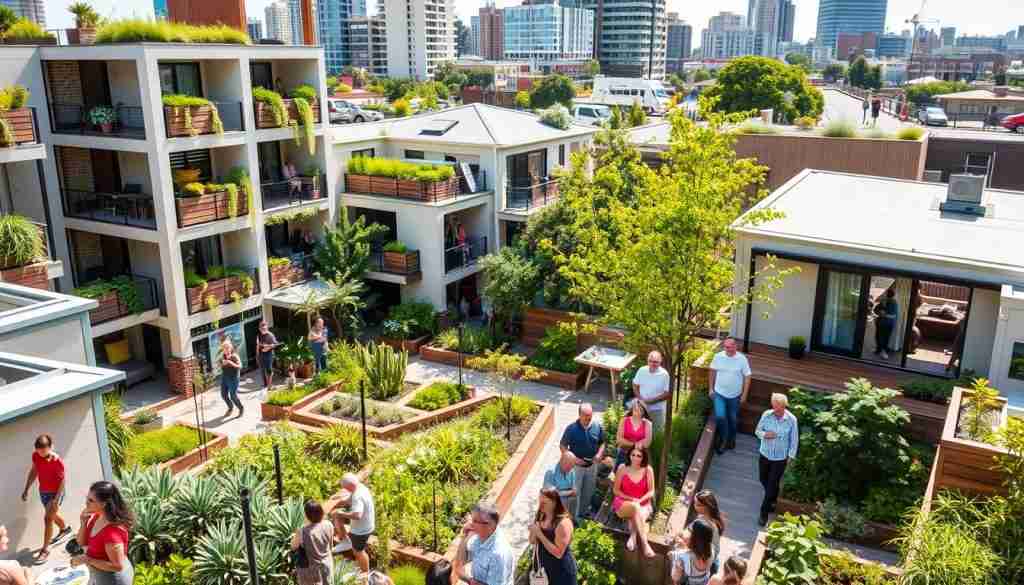
Creating Social Bonds in Urban Life
Urban living can make it hard to meet neighbors. But, places like The Commons and Nightingale Housing focus on communal areas. These spaces, like roof gardens and laundry rooms, help residents chat and form friendships.
Connecting with the Broader Urban Community
Co-housing does more than just connect neighbors. It also helps residents engage with the wider city. By joining local events and supporting local businesses, co-housing residents make their city better. This way, co-housing becomes a part of the city’s life.
| Co-Housing Development | Communal Facilities | Percentage of Property Devoted to Communal Spaces |
|---|---|---|
| The Commons | Shared roof garden, laundry room | 15% |
| Nightingale Housing | Communal dining area, kitchen, multi-purpose spaces, guest rooms | N/A |
Organizing Events and Activities
Co-housing developments keep their communities lively with events. These include meals, workshops, and holiday parties. Such activities help residents connect and build strong relationships. They also make newcomers feel welcome.
“Living in an urban co-housing development has transformed my experience of city life. I now have a strong network of friends and neighbors who support and care for one another. It’s like having an extended family right in the heart of the city.”
As cities in Australia grow, so does the need for co-housing. It’s a way to create a sense of belonging and well-being. By focusing on social bonds and community events, co-housing offers a bright future for city living.
Overcoming Regulatory Barriers in Urban Co-Housing in Australia
Urban co-housing in Australia comes with many benefits. But, it faces big challenges in the complex regulatory landscape. Zoning, building codes, and legal frameworks are just a few hurdles. With careful planning and working with local authorities, it’s possible to overcome these challenges and create thriving co-housing projects.
Zoning and Urban Planning in Australia
Zoning laws are key in making urban co-housing projects work. In many cities, zoning separates residential from commercial areas. This can limit co-housing options. Yet, some local governments are starting to see the value of mixed-use developments.
Co-housing groups can work with local planners early on. By showing the benefits of co-housing, they can push for zoning changes. This allows for diverse, inclusive, and sustainable neighborhoods.
Navigating Building Codes in Australia
Building codes ensure homes are safe, accessible, and energy-efficient. But, they’re often made for single-family homes. This can be a challenge for co-housing, which focuses on shared spaces.
Co-housing groups can work with architects and engineers who get co-housing. By using universal design and energy-efficient tech, they can meet building codes. This way, they can still build vibrant, inclusive communities.
Legal Framework for Urban Co-Housing in Australia
A clear legal framework is crucial for co-housing projects. It defines ownership, decision-making, and how to solve disputes. This should match the community’s values and goals.
In Australia, co-housing can use strata title, community title, or cooperative ownership. Each has its pros and cons. The choice depends on the community’s size, shared ownership, and autonomy needs.
Co-housing groups should get legal advice from experts in alternative housing. Clear agreements that outline everyone’s rights and duties are key. This sets a strong foundation for the project’s success.
The Future of Urban Co-Housing in Australia
Urban co-housing is growing in Australia, offering a promising future. It meets the need for affordable, sustainable, and community-focused housing. This makes it a key player in Australia’s urban living future.
Expanding Co-Housing in Cities in Australia
Several factors are driving the growth of urban co-housing in Australia. Housing costs in cities are high, making co-housing a good alternative. UNSW’s City Futures Research Centre says there’s a big shortage of affordable homes.
Also, more people want to live sustainably and build community. Urban co-housing offers these benefits, attracting those who care about the environment and community.
Emerging Trends in Urban Living in Australia
New trends are shaping co-housing in Australia. The Build-to-Rent (BTR) market is growing, offering long-term rentals with extra services. This is a new way to live in cities.
Co-living is also expanding, appealing to first-time buyers, young professionals, and key workers. It combines private and shared spaces, making housing affordable and community-focused.
| Emerging Trend | Description |
|---|---|
| Build-to-Rent (BTR) | Long-term rental housing with added amenities and services |
| Co-Living | Mix of private and shared spaces, catering to various demographics |
| Seniors Living | Housing options tailored to the needs and capacities of seniors |
Impact of Technology on Urban Co-Housing in Australia
Technology is key in urban co-housing. It includes smart homes, shared digital platforms, and online tools. These help manage the community, improve security, and encourage interaction.
Online platforms help manage shared resources and plan events. Smart homes reduce energy use and make living sustainable. Technology also helps in communication and decision-making, ensuring everyone’s voice is heard.
“Flexibility and incentives will be critical in enabling the market to deliver alternative housing forms such as BTR, ‘seniors living’, and low-cost housing.” – Ethos Urban
Urban co-housing is changing how we live in cities in Australia. It combines new trends, technology, and community spirit. This offers a sustainable, affordable, and connected living option for Australians.
Final Thoughts
Urban co-housing in Australia is becoming a key solution for living sustainably in cities. It focuses on community, affordability, and caring for the environment. The South Hobart Cohousing Co-operative shows how it works, with members paying no more than 30% of their income in rent.
In Melbourne, old buildings like hospitals and hotels are being turned into co-housing spaces. This shows how urban co-housing can change the way we live in cities.
As more Millennials and Gen Zs join the workforce, the need for urban co-housing will grow. These spaces offer both private and shared areas, meeting residents’ needs for alone time and socializing. Using green building methods like prefabrication will help keep these homes affordable and lasting.
Despite challenges like dealing with rules and high land costs, the benefits of urban co-housing are clear. It helps people connect, cuts down on environmental harm, and makes housing more affordable. As more people see its value, urban co-housing will help make Australian cities more sustainable and connected.
For more on co-housing and sustainable living, check out Sustainable Home Magazine.
FAQ
What is Urban Coup and how does it foster community spirit?
What are the features of the Urban Coup building at 24 Hope Street in Brunswick?
What are the sustainability features of the Urban Coup building?
How can someone get involved with Urban Coup or create a new co-housing project?
What is Sydney Cohousing and what are their goals?
How can someone become a member of Sydney Cohousing?
What is Vigilanti’s role in urban co-housing in Australia?
What is the significance of the name “Urban Coup”?
Source Links
- https://www.unisa.edu.au/media-centre/Releases/2024/innovative-urban-living-concept-tackles-housing-woes/
- https://architectureau.com/articles/how-co-housing-could-make-homes-cheaper-and-greener/
- https://www.urbancoup.org/cohousing
- https://transitionaustralia.net/site/cohousing-australia/?subpage=resource&ID=7364
- https://bccm.coop/wp-content/uploads/2023/01/Housing-Co-operatives-in-Australia.pdf
- https://www.abc.net.au/news/2022-07-22/communal-living-reduce-cost-of-living-loneliness/101146464
- https://www.ahuri.edu.au/sites/default/files/documents/2021-09/AHURI_Positioning_Paper_No41_Housing_policy_and_sustainable_urban_development.pdf
- https://www.diva-portal.org/smash/get/diva2:830137/FULLTEXT01.pdf
- https://transitionaustralia.net/site/cohousing-australia/

